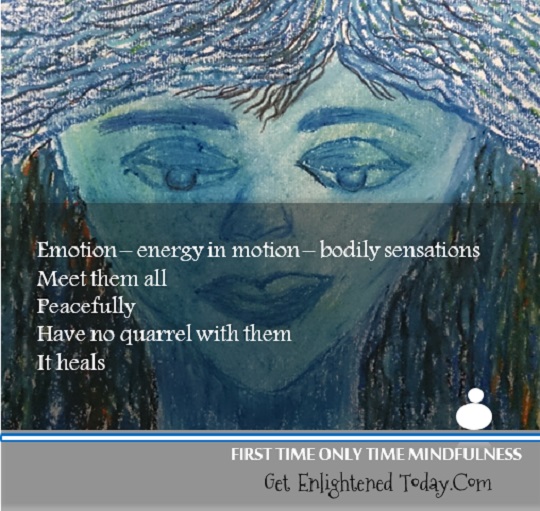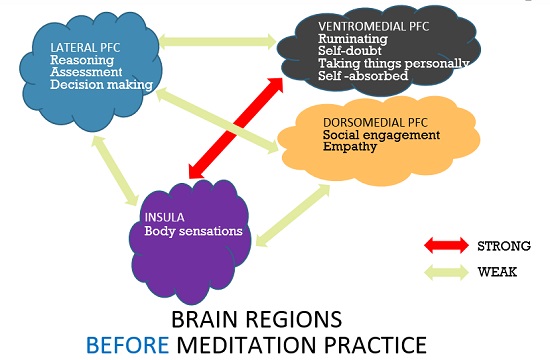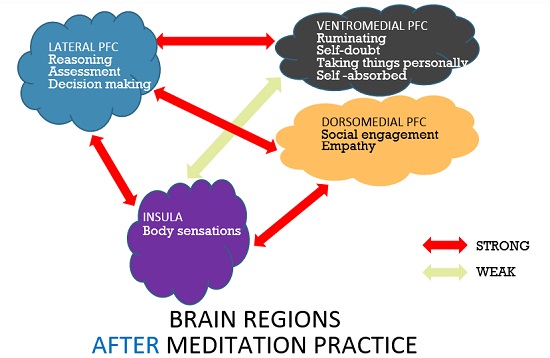Some of our thoughts have such a strong impact on us because we have either SUPPRESSED or REINFORCED them. Think about it.
It is estimated that we have between thirty to sixty thousand thoughts a day, (mostly repetitive). Why is it that most of them don’t bother us? Why is it that just some, perhaps one or two, simply keep returning again and again and bring with them (or so it seems) such emotional discomfort?
There is unfinished business here. Either we have been trying to push our thoughts and feelings away and it is in that pushing away or resisting that our energy is trapped. Or we have been trying to suppress them which again is an energy trap. Or we keep holding on to them, called ‘attachment’ in Buddhism, and of course, that’s again another energy trap.
Attention directs the flow of energy. Where attention goes, energy follows
Attention directs the flow of energy. Where attention goes, energy follows. So, whether your attention is on not wanting (resistance or suppression) to have a certain thought or feeling or wanting (attachment) to dwell on it, that’s where your energy is held. Physically, it feels ‘bad’ or unpleasant in the body because that energy is trapped in it instead of being given a chance to dissipate in its own natural way. Your attachment or resistance is holding your energy.
The psychological or cognitive component of these unpleasant emotions (expressed as bodily sensations) are the conclusions that the mind has made about what these emotions reflect. In the simplest terms, these conclusions reinforce feelings of guilt, shame, unworthiness, insecurity, powerlessness and so on.
The best way you can release the energy that is trapped in your body is by ALLOWING the thought and the emotions that are associated with it to fully express themselves in your body. When you do this consistently, changes take place in your brain and body that reflect the release of this trapped energy and the new thinking patterns (neural connections) that are being created.
This is how your mind and body can be consistently restored to or maintained in its natural state of peace and wellbeing. And this is exactly what happens when we practice mindfulness. By simply allowing our attention to rest softly, peacefully and non-judgmentally on whatever thoughts, emotions or body sensations arise, we allow them to express themselves fully and dissipate naturally. You see, mere attending does not keep energy trapped but attachment, resistance or suppression does!
Mere attending (mindfulness) does not keep energy trapped but attachment, resistance or suppression does
Now, some of our experiences (which become mental stories) are particularly discomforting and notoriously generate a cascade of thoughts a day and even days, months or years later. Each time the memory of the experience arises, more thoughts gather around it including some relating to things that did not upset you at the time of the incident but which now draw your attention giving you ever more cause for upset!
In such cases, you might need to repeat the process of allowing your thoughts and emotions to fully express themselves in your mind and body each time they arise before all the emotions are fully released. It is as if the release happens in stages, the first stage often releasing the bulk of the trapped energy and the later stages releasing what is left, bit by bit. That said, sometimes it also happens that some of the strongest releases happen later rather than earlier in the track.
Since emotion is energy in motion, when emotions are stuck, energy is stuck and that leaves us feeling less than well. Learn to accept and recognize your feeling of unwell-ness as a simple matter of energy being trapped in your body, as emotion being prevented from its natural motion or movement.
There is nothing wrong with the emotions that we experience whether it is rage or lust or guilt or sadness. They are nothing more than energy states which must be allowed to naturally dissipate. If we treat them as part of the human experience rather than pathologize them, we would be able to approach them with no more concern than we would a sneeze or a pebble in our shoe. After all, all it needs is for us to allow the energy of our emotions to continue its natural movement rather than stay trapped within our body.
When I began practising meditation consistently in 2001, the thing that helped me almost instantly and so powerfully and profoundly was the realization that I was not my thoughts or my emotions and that these were nothing more than events or phenomena taking place in consciousness. I learned how to simply notice these thoughts and emotions as they arose in my mind and body, sometimes with a mental comment: Fear is happening, Tightness is happening, Sadness is happening, Anger is happening, Burning is happening…. reflecting the sensations I was feeling in different parts of my body and the thoughts that were associated with them.
This ability to not identify with my thoughts or emotions was liberating beyond words. I’d say it cut down my experience of suffering by at least eighty percent! It was because of this that I had the urge to help everyone experience such relief from suffering especially because it wasn’t just a ‘flash in the pan’ experience but was in fact enduring and life changing. Science and Psychology attempt to explain how this kind of change happens on a neurological, physiological and psychological level.
Today, for instance, we talk a lot about brain or neuroplasticity which refers to the more lasting changes that the brain physically undergoes when we consistently think different thoughts and experience different emotional states. This is a reversal of a previous assertion that brain growth or change reached a static state by the age of twenty or so. Instead, Science now finds that brain growth or change continues indefinitely although there might be some slowing down as we age.
For instance, the brains of meditation practitioners show thickening in certain areas such as the lateral prefrontal cortex and a thinning in other areas particularly the amygdala. Scientists map brain activity during conscious reasoning, assessment and decision making to regions such as the lateral prefrontal cortex while the amygdala is known as the region for reactive fear, flight or lockdown arousal.
In other words, the practice of meditation is directly linked to changes in the brain which increasingly predispose practitioners to enhanced reasoning and decision making (or enhanced cognitive flexibility) while diminishing their reactive fear states and the behaviours that these typically generate (such as anxiety, phobias, addictions and depression)
More specifically, we’re looking at three regions in the brain – the medial prefrontal cortex, the insula and the lateral prefrontal cortex. The first seems to be mapped to two different kinds of activity:
The ventromedial prefrontal cortex maps activity relating to your relationship with yourself and the people that you perceive to be similar to you. This is activity that reflects self-absorption, rumination, worry and the habit of taking things personally.
The other part of the medial prefrontal cortex, the dorsomedial prefrontal cortex, maps activity relating to your relationship with people you perceive as different to you and within which you are able to respond empathetically. Activity here reflects less absorption with self and more interest in the wellbeing of others as well as greater social engagement.
The second region of the brain, the insula, is mapped on to body sensations such as pulsing, tingling, itching and so on.
The third part of the brain that is of interest here is the lateral prefrontal cortex. or the reasoning and assessment centre.
A person whose brain shows weak neural connections between the ventromedial prefrontal cortex and the reasoning/assessment centre (lateral prefrontal cortex) of the brain and strong connections with the insula (body sensations) is more likely to be someone whose response to feelings of anxiety or uncertainty and bodily sensations such as tingling or tightness is greater anxiety, worry and depression, believing that there is something wrong with them (sometimes called ‘catastrophizing’).
Yet, following a period of meditation practice, the nature of these connections reverse. Now, the connections between the ventromedial prefrontal cortex and the reasoning/assessment centre (lateral prefrontal cortex).of the brain are stronger while the connections with the insula are weaker.
What this means is that the person is less likely to be worried or feel anxious when body sensations are triggered by memories or situations that would typically be experienced as difficult or overwhelming. This happens because the reasoning/assessment centre of the brain now has greater influence over the worry/ruminating part of the brain i.e. the ventromedial prefrontal cortex.
Meanwhile, the dorsomedial prefrontal cortex which maps the empathy response builds stronger connections with the body sensation processing part of the brain (the insula) as well as the reasoning/assessment centre of the brain, the lateral prefrontal cortex. This is a whole new kind of relationship between body sensations and the brain and what it means is that you develop greater empathy towards others including those that you perceive to be different to you. And your social engagement begins to pick up (again).
Note, all this happens WITHOUT any active, deliberate brain rewiring through thinking, analysing, cogitating etc. Rather, it happens as a result of consistent mindfulness practice – the simple, non-judgmental, gentle attending, noticing or observing of anything that arises in our stream of consciousness.
Some people think that this is too simple to have such profound and lasting effects. I hope you’re not one of them. I’ve learned many things in my life journey and one of them is that the best solutions are almost always the most simple and by virtue of their simplicity, the most elegant. I also know (and many people I know and have met have experienced) the benefits of the changes that have happened to me as a result of my practice over the last twenty years. And I haven’t even told you about the physical health benefits of my practice and those experienced by countless other practitioners, some almost instantly!
Does this mean that every problem can be resolved through mindfulness practice? What about my partner who gambles and puts our family at risk? What about the boss who seems to have it in for me? What about my child who is suffering from depression? How will mindfulness solve any of these?
Here is how I see it:
The practice of mindfulness does not preclude or reject methods of problem solving such as seeing a mentor or counsellor, other health practitioners, spiritual teachers, reflecting, developing good communication skills, setting short and long term goals and so on. On the contrary, it welcomes all of these. The difference is that mindfulness practice puts your mind, brain and body in a state of openness, peace, presence, kindness, empathy, power and far greater cognitive flexibility and curiosity than you would otherwise have thus making you more open to change/learning. Interestingly, this often has the effect of redefining what you would typically consider a ‘problem’.
[In my case, I began to see things as ‘events’ rather than problems. In fact, mindfulness practice put me on a trajectory of being much more mindful about my use of language. Certain words became less and less meaningful or appropriate for me. Words such as ‘challenge’ and ‘difficult’ and ‘can’t’, for example.]
When we respond to ideas, situations and people with presence (or greater presence), we are less likely to be reactive and habitual in our thoughts, words and actions and trigger (or reinforce) more of the reactions and their predictable results from ourselves and others. Instead, we are more likely to be open, flexible, less judgmental of others and of ourselves, and more willing to empathize and see things from another person’s perspective. We are less imprisoned by our own beliefs, biases, attitudes and expectations about how things ‘should be’. We are more accepting of how things are while creatively (rather than forcefully) seeking new and better ways of being and doing things.
If you have never experienced Mindfulness Meditation, why not give it a go today? Or, if you have but have not maintained a consistent practice, start again. Today. Right now.
Join or Start a Mindfulness Circle today!
 MENTORING
MENTORING
Let Life express itself intoxicatingly, uniquely, powerfully and limitlessly in, as and through you. Don’t settle, whatever your age. Know your true Self. Follow your Bliss. Live the Life that you know you want to! Contact me here.
MINDFULNESS ONLINE
Join me every week to sit in the presence of your true Self and experience the greatness of Life flowing naturally, effortlessly and powerfully in, as and through you!


